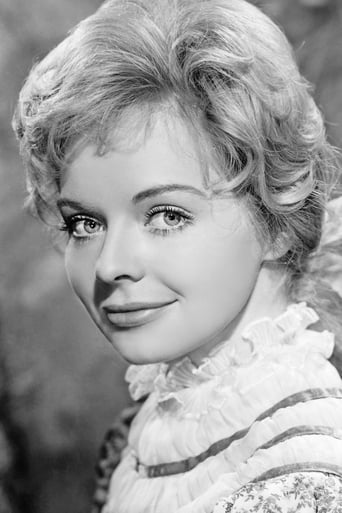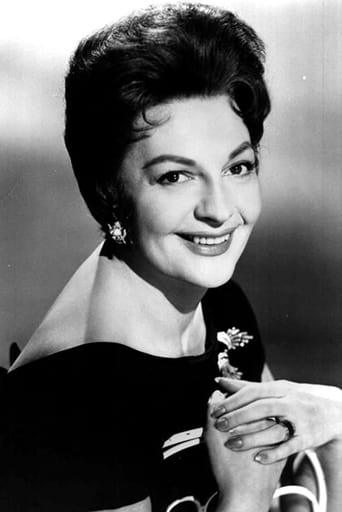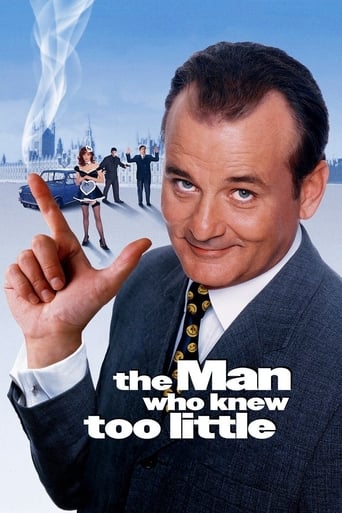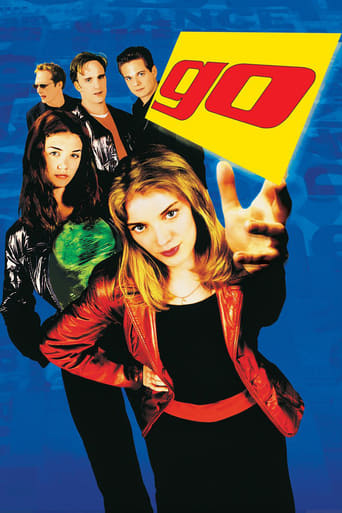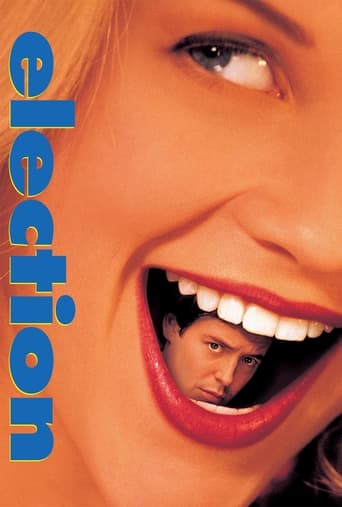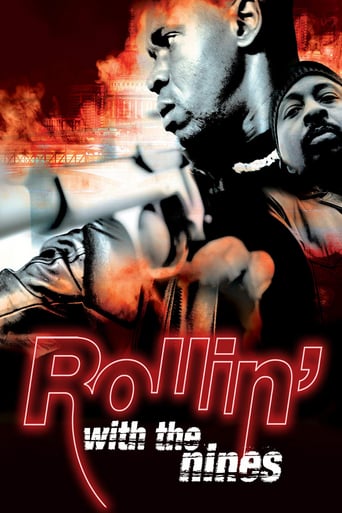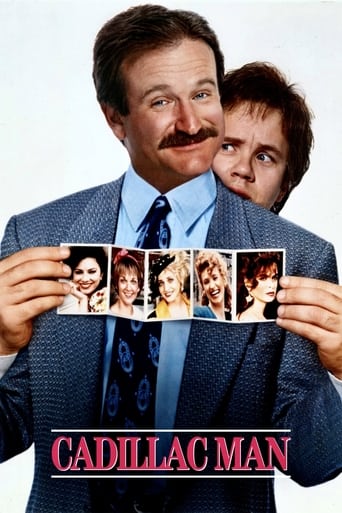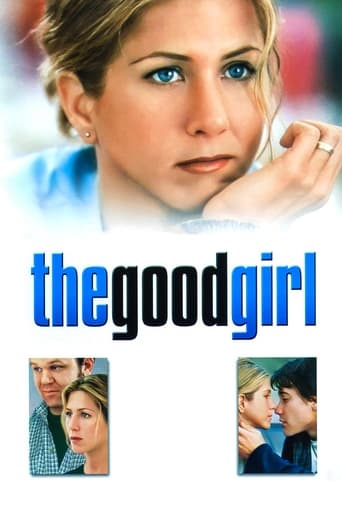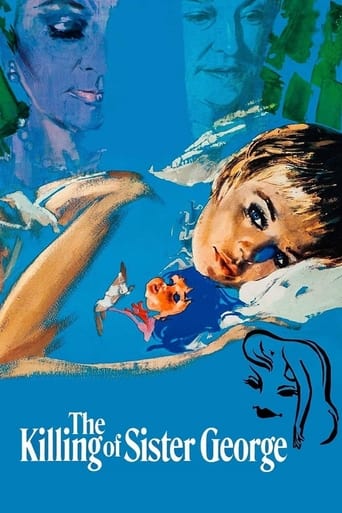
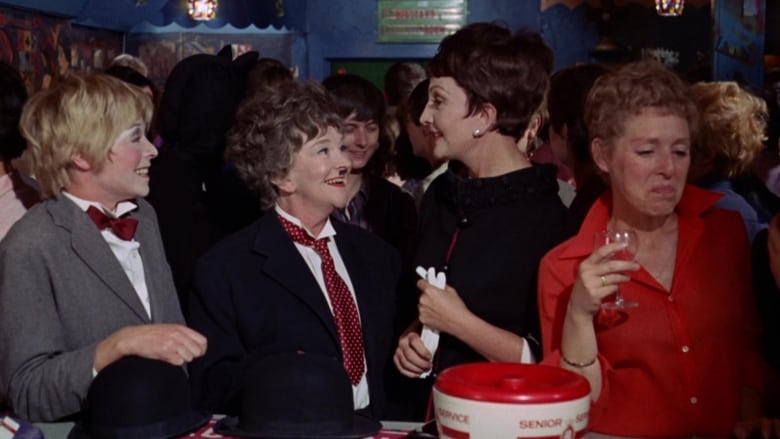
The Killing of Sister George (1968)
When June Buckridge arrives at her London flat and announces 'They are going to murder me', her long-time lover and doll-cuddling flat mate Alice 'Childie' McNaught realizes that things are going to change. For June is referring to her character 'Sister George', a lovable nurse she portrays in a popular daytime serial. To make matters worse, the widowed executive at the BBC responsible for the decision to kill off Sister George - Mercy Croft is also a predatory lesbian who is after Childie and will stop at nothing to get what she wants.
Watch Trailer
Cast


Similar titles
Reviews
Yawn. Poorly Filmed Snooze Fest.
Waste of time
Best movie of this year hands down!
In truth, there is barely enough story here to make a film.
One of the earliest British gay-themed films ever made, this tells the tale of June 'George' Buckridge, the soon to be eclipsed star on the TV soap opera Applehurst. We see her relationship with the Baby Doll-like Childie and also the interventions of television executive Mrs Crofts. But does Crofts have her own agenda?This lesbian drama has the amazing tagline 'The story of three consenting adults in the privacy of their own home' which obviously mimics the mantra of liberals and homophobes alike regarding 'the gays'. It's also a reference to the wording of The Sexual Offences Act of 1967 decriminalising homosexuality. There's something aesthetically pleasing about Beryl Reid in all of the films and TV programmes I've seen her in. This film is no exception. She plays George and she dominates proceedings whenever she is on screen. Her character is irreverent, rambunctious and a sheer delight. She's 'punk' years before the punk movement actually erupted. Also, notice how she plays her rebellious character to perfection and got under the skin of George. This is very evident in her body language. No unconscious crossing of the legs or keeping them together when she sits down. She can manspread with the best of them. This is a headstrong woman who lives life on her own terms rather than conforming to societal norms regarding how a 'lady' should act.Part of the film takes place in the real life lesbian bar The Gateways Club which was then in Chelsea, just off The Kings Road. The film used the real patrons as extras and it feels so natural it's as if the crew just went in and filmed without warning. The wide range of cast extras show that the uneducated myth about lesbians being either 'butch' or 'femme' is a fallacy and the locale provides a fascinating peek inside not just 1960's Gay London but specifically Lesbian London. George and Childie are also dressed as Laurel and Hardy in this scene which makes it even more joyous, surreal and brilliant.A primary theme of the film is the power play within the character's relationships. This is nicely shown in the 'contrition game' scene in which rather than being degraded by George's task, Childie makes herself enjoy it thus taking away the power from George and being in control herself. The film depicts it's characters like human beings with all of their foibles rather than as freaks in a sideshow to be leered at and grimaced at by 'them there normal folks'. The film prompts a new discussion on our perceptions of gay people in a Britain in which homosexuality had just been decriminalised (this was carried out in 1967- the year before this film was released). The tagline for the film also references the wording used in The Sexual Offences Act.The Killing of Sister George was unsurprisingly very contentious with the unenlightened British Board of Film Classification when it was due to be released. The main bone of contention was with the scene between Childie and Mrs Crofts- Crofts kisses and caresses Childie. There is nothing gratuitous about this scene and it is dealt with respectfully and mostly takes place off-screen. From the BBFC Case Study regarding the film-''(But) the BBFC was adamant that the scene be removed in its entirety. Trevelyan stated that the BBFC was "not prepared as yet to accept lesbian sex to this point.''It's unbelieveable today that the BBFC saw to not include this scene not because it may corrupt or adversely influence but because they thought the Great British public would have it's collective minds blown by such a scene.The BBFC Case Study on the film notes-''The BBFC classified The Killing of Sister George as 'X' in February 1969, with the encounter between Mrs Crofts and Childie deleted. Nevertheless, a number of local authorities across the UK banned the film even in this version. The Greater London Council allowed the film to be shown within its authority area with minor edits. The increase in the age bar for 'X' films from 16 to 18 in 1970 saw some local authorities relent on their previous decision and allow the film to be shown under this higher age restriction.''Today the film is thankfully uncut. This movie is an amazing time capsule, a perceptive and all too revealing glimpse into human relationships and a groundbreaking slice of LGBT history- a history that generally erases lesbians altogether. This film noisily and joyously bucks this trend. And audiences should be truly thankful for that.
I am very interested in pre-Stonewall gay life, and as such I was delighted to see this film. However, if I found it historically and cinematographically interesting, I didn't enjoy it per se. The George character is a lesbian that doesn't care to hide that she's a lesbian. She's not apologetic, which is good, but she also displays a certain number of traits which make it very difficult to like her: she seems to have no understanding of social norms or play. She's unable to conduct herself like an adult. She interrupts people at the bad moment, yells on her girlfriend and insults her in front of everyone, etc etc. She gets drunk all the time, and is a mean drunk. Why is she like that? You'll have the greatest difficulties to convince me that it is not some homophobic logic behind. Just the way the scene in the bar is filmed you understand from where the movie comes from: It is a film made by a heterosexual man for a (60s) heterosexual public. It is not by chance that she ends up alone, drunk and desperate. (read: The Celluloid Closet by Vito Russo...) In the end, I had heard that The Killing of Sister George and The Boys in the Band were two very homophobic movies made in the late 60s presenting gay people as desperate souls. I saw TBITB, and it went directly in my top 10 of all times movies, and I can argue against anyone who tells me it is homophobic. I tried to have the same take on TKSG, but I couldn't. While TBITB is a gay movie made by a gay man (not Friedkin, but Crowley) with gay people and for gay people (it used to be a play on Broadway), TKSG is a straight movie played by straight actors for a straight audience, and pretending to portray the life of lesbians as it is but failing miserably.
June Buckridge (Beryl Reid) plays a character named Sister George on a popular TV show. She gets word that her character is going to be killed and panics. She is also a lesbian and her relationship with her lover (Susannah York) is falling apart. Network executive Mercy Croft (Coral Browne) tries to help her...or does she?This movie has problems--it's way too long (almost 2 1/2 hours), has unlikable characters and is pretty depressing. Still it's very well-directed (I love the way the opening credits are done) and has three great performances. Reid had already been in the play on stage so she pretty much knew what she was doing. She's just great--you see her anger but also sympathize with her. York is very good as her lover. Browne is just superb as Mercy Croft. SPOILERS IN THE NEXT PARAGRAPH!!!! This was (for its time) pretty extreme. It was seen as a lesbian movie. In my opinion it really isn't. It's about an older woman whose behavior and attitude ends up destroying her. She just happens to be a lesbian. Still this was pretty raw for 1968. They shot the bar scenes in an actual lesbian bar in England and there was a sexual seduction in the movie that wasn't in the play. It's when Browne and York get together. York hated doing that scene and it shows. This got slapped with an X rating originally just for the subject matter alone. Director Robert Aldrich fought against that rating for years--he thought it deserved an R. It was re rated to an R in 1972. I remember it played here in Boston for months on end. Lines were around the block every night despite the rating. Still it was only a modest hit and quickly was forgotten. The stigma of the X rating still haunts this film which is too bad. No great masterpiece but worth seeing for the great acting by the three leads.
The Killing of Sister George (1968) THE KILLING OF SISTER GEORGE tells the story of June Buckridge, a middle-aged actress who portrays "Sister George" in a cosy weekly British TV soap opera called "Applehurst".In the show June, as "Sister George", is a sweet and charming District Nurse loved by all, but off-screen she has a more sinister side to her personality: she's a hard-drinking, foul-mouthed, cigar smoking lesbian, totally insecure in her relationship with the much younger Alice "Childie" McNaught (Susannah York).Into this insecure relationship arrives the spidery Mrs. Mercy Croft (Coral Browne), who indirectly gets June sacked from her television role and seduces June's lover into the bargain.Beryl Reid is sensational as June Buckridge. Using a wide variety of acting skills she makes the character completely her own. It's a memorable performance, but perhaps a bit too theatrical at times.Coral Browne fairs a bit better and simply oozes fake charm and arch superiority. She's positively malevolent. Her every line of dialogue and facial expression seem to drip with evil intent. What a great performance.Susannah York is a bit hard to take as "Childie". She's simply the wrong actress for the role because she appears to be too old and her personality is too "strong" for someone who is supposed to have been dominated by her lover.The film, directed by Robert Aldrich, will be a bit too full-on for most audiences. In the play on which the film was based, the lesbian relationship was only hinted at, never really mentioned. But in the film, however, Aldrich hits you over the head with it again and again.Be warned: the trip to The Gateways Club (a lesbian bar) maybe a bit too shocking even in this day and age for some viewers.A good film, but it could do with some pruning, but definitely worth seeing for Beryl Reid and Coral Browne's performances.



